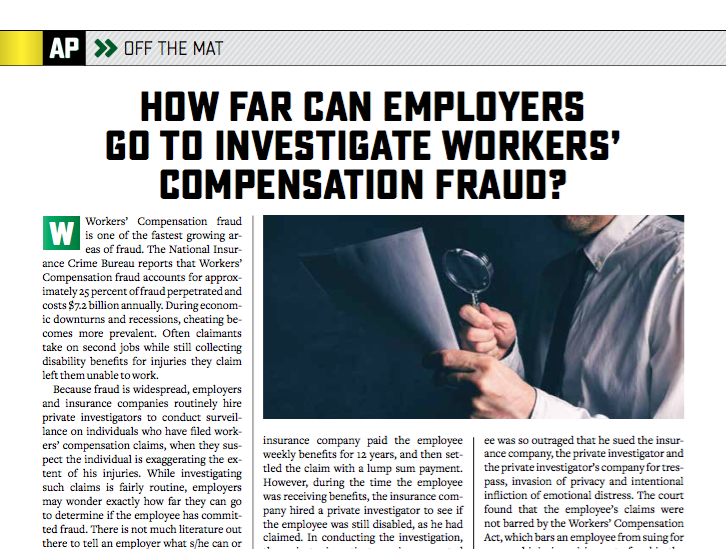How Far Can Employers Go to Investigate Workers’ Compensation Fraud?
BY Lorraine D'Angelo

By Lorraine D’Angelo & Silvia Zicherman
Workers’ Compensation fraud is one of the fastest growing areas of fraud. The National Insurance Crime Bureau reports that Workers’ Compensation fraud accounts for approximately 25 percent of fraud perpetrated and costs $7.2 billion annually. During economic downturns and recessions, cheating becomes more prevalent. Often claimants take on second jobs while still collecting disability benefits for injuries they claim left them unable to work.
Because fraud is widespread, employers and insurance companies routinely hire private investigators to conduct surveillance on individuals who have filed workers’ compensation claims, when they suspect the individual is exaggerating the extent of his injuries. While investigating such claims is fairly routine, employers may wonder exactly how far they can go to determine if the employee has committed fraud. There is not much literature out there to tell an employer what s/he can or cannot do. However, based on a lawsuit in Maine, using trickery or deception may be going too far, and could make an employer or an insurance company that uses such tactics liable for damages to the employee.[1]
In that case, an employee was injured while working on the job. The employer’s insurance company paid the employee weekly benefits for 12 years, and then settled the claim with a lump sum payment. However, during the time the employee was receiving benefits, the insurance company hired a private investigator to see if the employee was still disabled, as he had claimed. In conducting the investigation, the private investigator misrepresented who he was to gain access to the employees’ home and win over his confidence.
He posed as a person interested in building a home, and asked the employee questions about who built his home. The employee, not realizing the person was an investigator, gave him a tour of his home, showed him receipts from the contractor that built his home and mentioned that he did the landscaping himself. The investigator left and came back another day where he videotaped the employee painting, shoveling manure and mowing his lawn on a riding lawn mower.
The employee did not find out he was under investigation until two years later when the surveillance photos and video were sent to his attorney before his workers’ compensation hearing. The employee was so outraged that he sued the insurance company, the private investigator and the private investigator’s company for trespass, invasion of privacy and intentional infliction of emotional distress. The court found that the employee’s claims were not barred by the Workers’ Compensation Act, which bars an employee from suing for personal injuries arising out of and in the course of employment, because he was suing for compensation for economic injuries that arose from conduct that occurred at his home rather than at his job.
This case is important because it demonstrates that there are limits in how far an employer or insurance company can go when it conducts an investigation of a workplace injury. The employer or insurance company must always remember that the employee still has a right to privacy. Based on this case, it appears that using false pretenses to gain access to an employee’s home is going too far. Similarly, it would seem that any type of deceptive conduct, such as, perhaps, friending someone on their social media, to gain access to information on their private accounts may also be going too far.
Even though an employer has limits in how it is able to investigate, it can implement a careful blend of humanity, technology and process to ensure that suspicious injuries do not enter the system undetected. Here are some strategies an employer can use:
1. Communicate with Your Employees.
Don’t underestimate the importance of a personal touch both before and after a workplace injury takes place. Person-to-person contact is an effective tool to prevent and detect fraud. Manager and supervisor contact lets the employee know that he is valued, missed at work, and expected to recover and return to work.
2. Leverage Publicly Available Social Media Information.
Although “friend requesting” may go too far, it is not against the rules to review what an employee posts and makes available to the public. Often, workers cheating the system are caught because they boast on social media about having a second job.
3. Implement Process.
Maintain an injury hotline and encourage same-day reporting, which captures all the pertinent information surrounding an injury. Prompt reporting lessens the opportunity for exaggerating the nature of the claim or the severity of the injury. A contemporaneous report documenting the injury and incident could assist with detecting later inconsistencies.
4. Educate and Train.
Make your employees aware of your internal policies regarding reporting workplace injuries and train them on how to report an injury. Monitor to make sure that managers and supervisors know that retaliation for reporting is not permitted. Communicate that the company values prevention of workplace accidents in the first place.
Again, this blend of humanity, technology and in-place process lets employees know that their health and safety is of value to the company. The consistent implementation of these steps also helps to protect the company in the event that an employee might be tempted to commit workers’ compensation fraud.
 Lorraine D’Angelo, a nationally recognized expert on legal and regulatory risk management, is the president of LDA Compliance Consulting Inc. She has more than 25 years of experience in the construction industry, including a recent tenure as senior vice president for ethics and compliance at a global construction company. D’Angelo is an accredited ethics and compliance professional and a leading expert on small, women-owned, minority and DBE matters, programs and policy implementation. For more information, contact her at (914) 548-6369 or Lorraine@ldacomplianceconsulting.com.
Lorraine D’Angelo, a nationally recognized expert on legal and regulatory risk management, is the president of LDA Compliance Consulting Inc. She has more than 25 years of experience in the construction industry, including a recent tenure as senior vice president for ethics and compliance at a global construction company. D’Angelo is an accredited ethics and compliance professional and a leading expert on small, women-owned, minority and DBE matters, programs and policy implementation. For more information, contact her at (914) 548-6369 or Lorraine@ldacomplianceconsulting.com.
[1] Hawkes v. Commercial Union Insurance Co., 2001 ME 8.
